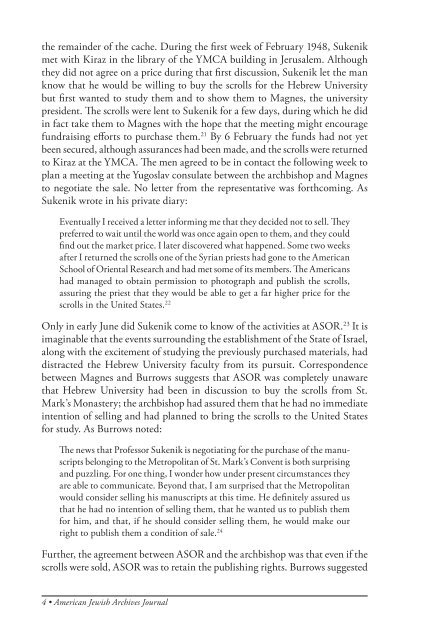The American Jewish Archives Journal, Volume LXI 2009, Number 1
The American Jewish Archives Journal, Volume LXI 2009, Number 1
The American Jewish Archives Journal, Volume LXI 2009, Number 1
You also want an ePaper? Increase the reach of your titles
YUMPU automatically turns print PDFs into web optimized ePapers that Google loves.
the remainder of the cache. During the first week of February 1948, Sukenik<br />
met with Kiraz in the library of the YMCA building in Jerusalem. Although<br />
they did not agree on a price during that first discussion, Sukenik let the man<br />
know that he would be willing to buy the scrolls for the Hebrew University<br />
but first wanted to study them and to show them to Magnes, the university<br />
president. <strong>The</strong> scrolls were lent to Sukenik for a few days, during which he did<br />
in fact take them to Magnes with the hope that the meeting might encourage<br />
fundraising efforts to purchase them. 21 By 6 February the funds had not yet<br />
been secured, although assurances had been made, and the scrolls were returned<br />
to Kiraz at the YMCA. <strong>The</strong> men agreed to be in contact the following week to<br />
plan a meeting at the Yugoslav consulate between the archbishop and Magnes<br />
to negotiate the sale. No letter from the representative was forthcoming. As<br />
Sukenik wrote in his private diary:<br />
Eventually I received a letter informing me that they decided not to sell. <strong>The</strong>y<br />
preferred to wait until the world was once again open to them, and they could<br />
find out the market price. I later discovered what happened. Some two weeks<br />
after I returned the scrolls one of the Syrian priests had gone to the <strong>American</strong><br />
School of Oriental Research and had met some of its members. <strong>The</strong> <strong>American</strong>s<br />
had managed to obtain permission to photograph and publish the scrolls,<br />
assuring the priest that they would be able to get a far higher price for the<br />
scrolls in the United States. 22<br />
Only in early June did Sukenik come to know of the activities at ASOR. 23 It is<br />
imaginable that the events surrounding the establishment of the State of Israel,<br />
along with the excitement of studying the previously purchased materials, had<br />
distracted the Hebrew University faculty from its pursuit. Correspondence<br />
between Magnes and Burrows suggests that ASOR was completely unaware<br />
that Hebrew University had been in discussion to buy the scrolls from St.<br />
Mark’s Monastery; the archbishop had assured them that he had no immediate<br />
intention of selling and had planned to bring the scrolls to the United States<br />
for study. As Burrows noted:<br />
<strong>The</strong> news that Professor Sukenik is negotiating for the purchase of the manuscripts<br />
belonging to the Metropolitan of St. Mark’s Convent is both surprising<br />
and puzzling. For one thing, I wonder how under present circumstances they<br />
are able to communicate. Beyond that, I am surprised that the Metropolitan<br />
would consider selling his manuscripts at this time. He definitely assured us<br />
that he had no intention of selling them, that he wanted us to publish them<br />
for him, and that, if he should consider selling them, he would make our<br />
right to publish them a condition of sale. 24<br />
Further, the agreement between ASOR and the archbishop was that even if the<br />
scrolls were sold, ASOR was to retain the publishing rights. Burrows suggested<br />
4 • <strong>American</strong> <strong>Jewish</strong> <strong>Archives</strong> <strong>Journal</strong>

















